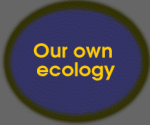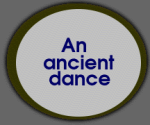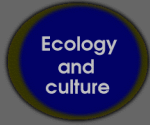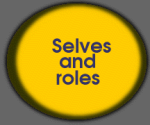Our own ecology
The term "ecology" as originally used in botany
and zoology referred to the relation of living organisms to their
surroundings, their habits and mode of life. (Oxford English Dictionary
1933 Edition).
The ancient greek "oecos" means a household, and so we have
the connotations of those multiple repeating interactions which go to
make up the life of a household.
Three ecologies
When we apply the word to our own lives, we
need to notice that our relationship to our surroundings, our habits
and our mode of life falls into several broad contexts. These seem to
be discontinuous with one another, yet in some strange way superimposed and simultaneous. We can think of these as three distinct, though
inter-related, ecologies. Each is a pattern of interlinked
relationships, of a similar order to those that have evolved in other
contexts - like the ecology of a seashore or a rainforest.
Inside us
Firstly the inner ecology, the set of processes
and balances called "physiology", the intricate order of the
ever-changing states of our body. This is, for each one of us, our
integral and secret chemistry, the energetic heart of our being.
Between us
Secondly, the ecology of community: the impact
of human bodies, every body we interact with - every look, every
gesture, every transaction which touches our lives. The sum of these
makes up a human world, and their collective quality will make the
difference - between a living community, an ant-heap existence, or a
world given over to predatory gangs stalking the ruins of civilisation.
Around us
Thirdly, there is the wider environment which
we share with all the other animals and plants. This is the living
earth, that earth so starkly evoked by Chief
Seattle in his celebrated (fictional) address of 1852.
"The environment" and the life-world
Chief Seattle helps to clarify for us the
limitations of much of the present-day concern for "the environment".
The modern version tends to strip out a single level of our ecology and
ignore the other two. This results in a sort of disembodied concern -
as if we were not a part of the earth, and the earth a part of us.
I wonder if it is even possible to care wholeheartedly for the
life and landscape surrounding you, if you are not also caring for the
life within yourself and the life which is bodied forth between
yourself and your neighbour?
Intricate blending of the three
This is the most ancient of dances, and whilst
it is true that we are forever losing the beat, it is also true that
the beat is ever there for us to hear.
For the same reason - the millions of lifetimes we have been
in this dance together - the pattern of our human relationships has a
similar synchronistic relationship with the other two levels of
ecology. This means that the search for genuine communion and sharing
with each other is intimately linked to the search for right
relationship at these other levels.
Fine tuning our
relationships
This is why it is a more realistic project to
try to fine-tune all three of these levels of our ecology together,
than to insist upon acting one-dimensionally in one arena at a time.
If this is right, it means that the same effort which works
towards salvaging our planet from the blight of rampant Western
materialism, can also help to restore to our inner life that sense of
delight, of communion, of deep satisfaction, which is nothing else than
the birthright of every creature born on this planet.
What does it mean: to consider our cultural
life as a kind of ecology? Firstly it is to recognize how our habits,
customs and individual impulses all take place in the context of our
life together. Our life begins in a mutual adaptation between ourselves
and our family, in which we learn the ways (and the language) of the
local culture. Our circle of contacts later broadens out to include the
wider community.
Recurring rhythms of life
These are multiple, repeating interactions
which fall into a relatively stable pattern of expectations,
frustrations, satisfactions and surprises. In this micro-environment of
human- to-human signals each of us evolves into a member of the culture
we were born to.

An important aspect of this is the parts, or
roles, we play in the repeating rituals which make up communal life. It
is always ambiguous, the extent to which we have chosen these
roles (none of us chooses the role of dependent infant, after all - nor
do we choose that particular pattern of customs which our family
expects us to fit in with), and the extent to which these are
prefabricated expect ations of the community, so that we simply "walked
into the part".
A margin of choice
I do not question that there is a margin of
personal initiative, in the way we respond to the allegiances and
traditions which are proffered us in situation after situation. We also
have some initiative in which situations we choose to approach, and
which we avoid. But there is a sense in which all of it was all waiting
for us, before we arrived on the scene. The cultural drama simply
borrows us for a while, for the purpose of its continuing enactment.
Mary Douglas' cultural theory
This, broadly, is the same position which the
cultural anthropologist Mary Douglas and an
increasing company of collaboraters developed in the latter decades of
the twentieth century. She claims there are just four main cultural
types which express themselves in a multiplicity of ways through the
entire spectrum of traditional and modern societies.
How this may be of use
It is no part of my project to try and convince
people that this cultural theory is "correct". The important question
is whether it can provide signposts or relevant feedback, for the
process of "fine tuning" which I am discussing elsewhere. This will
only be established by trying it out. I think this theory can also help
to understand why the simple procedures we shall be adopting,
could have such powerful effects. But this is a different discussion
altogether.


Illustration of
the cyclical, self-maintaining aspect of everyday activity
Here is an example of how I myself am placed
within the cyclical, self-maintaining patterns of interaction which I
am calling "ecological".
I write words on a page, expending physical energy obtained
from food, even as more food is now being digested in my stomach, which
will replace the energy presently being used in writing (and keeping me
alive while I write). These are already interwoven cyclical processes
of the kind I am talking about.
This is going on even as more plants and animals are growing
somewhere in the world - replacing the plants and animals presently
providing me with food, and offering me the hope that there will be
more food for me on subsequent days. Thus, more cyclical processes.
If the writing is successful, then it contributes to another
set of cyclical processes altogether, that of the literary and
practical culture to which I address these words.
What if I lived in the Amazon Rain Forest?
If I lived in the Amazon rain forest, amongst
people who knew their place within the cycles of living processes
surrounding and including them, I would probably be writing with
locally gathered and worked materials. And the activities of gathering
food and other materials would be integrally related to the life of the
forest - they would in a hundred ways contribute to the
replenishment of that life.
And all my waste products, gasses breathed out, sweat
evaporated, urine and faeces expelled, old writing materials discarded,
all would be restored to the cycle of substances and energy which make
up the continuing ecology of the forest.
My corpse, eventually, would be allowed to rot in contact with
other life forms which would use these substances in their
own cycles of transformation and replenishment.
So what if I did?
What lessons are to be drawn from this?
Certainly not that we must all run out to the forest today - even
supposing that we knew what to do when we got there. We have simply a
sketch, the merest illustration, of what cyclical, self-maintaining
processes look like, observed from a certain physical and chemical
viewpoint, and with a mind to the holistic workings of them.
| Try pressing the "back" button on your browser to
return to where you were |
return to the top |

"The President in Washington
sends word that he wishes to buy our land. But how can you buy or sell
the sky, the land? The idea is strange to us.
"Every part of this earth is sacred to my
people, every shining pine needle, every sandy shore, every mist in the
dark woods, every meadow, all are holy in the memory and experience of
my people.
"We are part of the earth and it is part of
us. The perfumed flowers are our sisters. The bear, the deer, the great
eagle, these are our brothers. The rocky crests, the juices in the
meadows, the body heat of the pony, and man - all belong to the same
family.
"Each ghostly reflection in the clear water
of the lakes tells of events and memories in the life of my people. The
water's murmur is the voice of my father's father. The rivers are our
brothers.
"If we sell you our land remember that the
air is precious to us, that the air shares its spirit with all the life
it supports. The wind that gave our grandfather his first breath also
receives his last sigh. This we know, the earth does not belong to man;
man belongs to the earth.
"All things are connected, like the blood
that unites us all. Man did not weave the web of life, he is merely a
strand in it. Whatever he does to the web, he does to himself.
"Your destiny is a mystery to us. What will
happen when the buffalo are all slaughtered? What will happen when the
secret corners of the forest are heavy with the scent of many men, and
the view of the ripe hills is blotted by talking wires? The end of
living, and the beginning of survival.
"When the last red man has vanished with
this wilderness, and his memory is only the shadow of a cloud moving
across the prairie, will these shores and forests still be here? Will
there be any spirit of my people left?
"We love this earth as the newborn loves its
mother's heartbeat. So, if we sell you our land, love it as we have
loved it. Hold in your mind the memory of the land as it is when you
receive it. Preserve the land for all children, and love it, as God
loves us all.
"One thing we know: there is only one God.
No man, be he red man or white man, can be apart. We are brothers,
after all."
| Try pressing the "back" button on your browser to
return to where you were |
return to the top |

© all content: copyright reserved,
Michael Roth, March 2009
|










